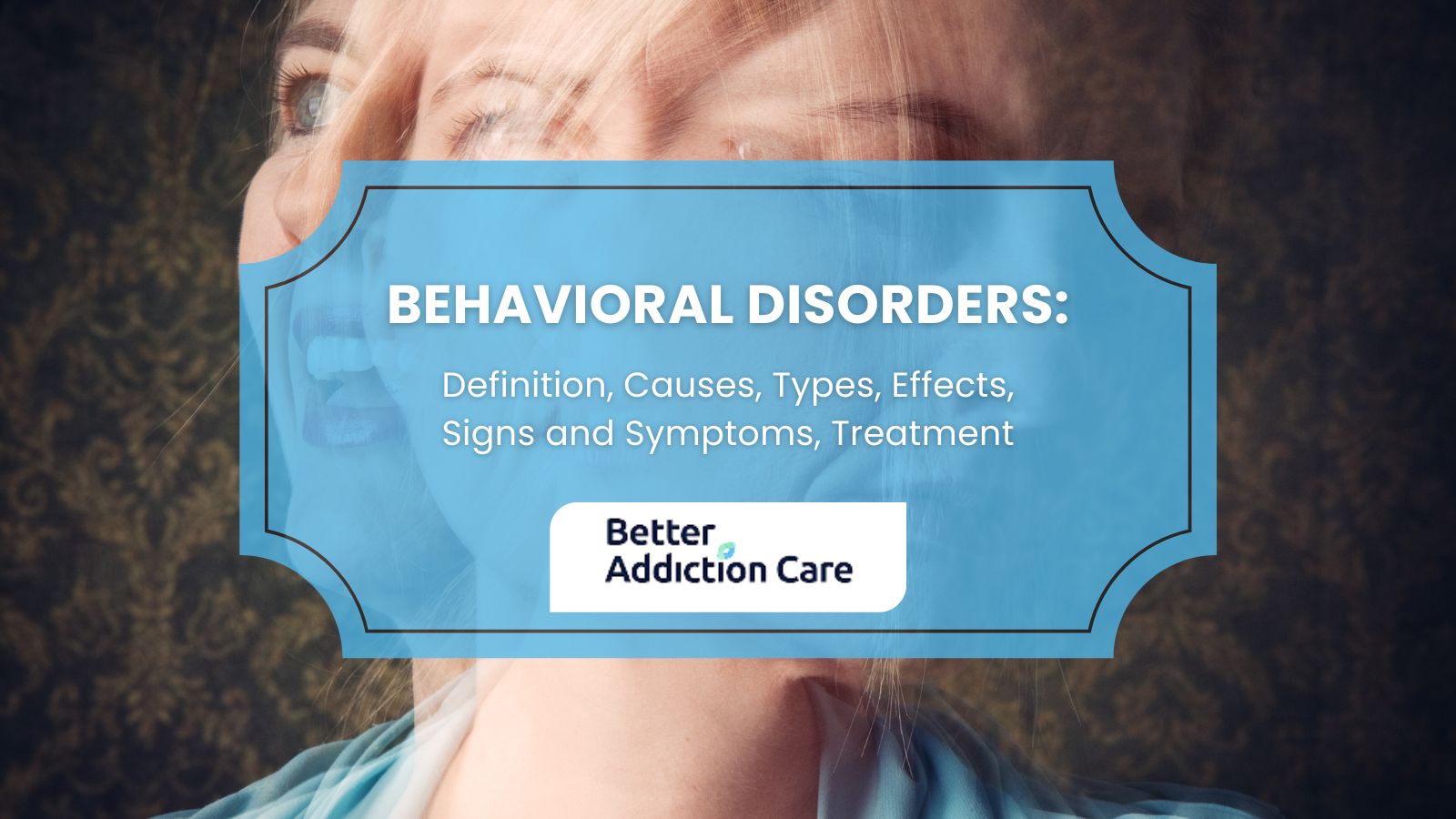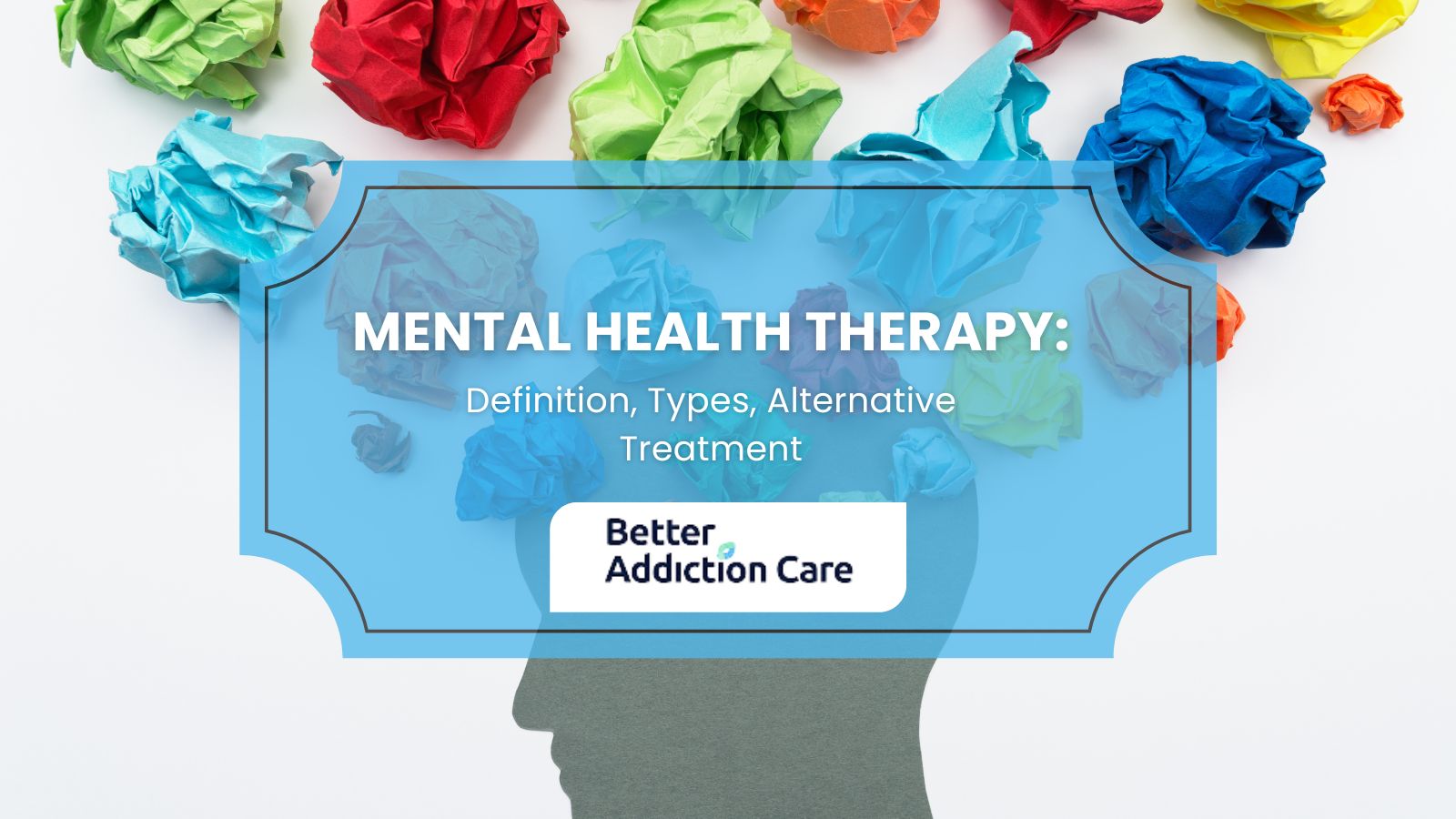Anxiety Disorders: Definition, Causes, Types, Effects, Signs and Symptoms, Treatment
Anxiety disorders are mental health conditions marked by persistent fear, worry, or nervousness that interferes with daily life. Unlike occasional anxiety, these disorders involve intense symptoms that disrupt thinking, emotions, and behavior, making it difficult to function socially and professionally. An estimated 19.1% of U.S. adults experienced any anxiety disorder in the past year, with higher rates among females (23.4%) compared to males (14.3% according to the National Institute of Mental Health (NIMH), "Any Anxiety Disorder" in 2023.
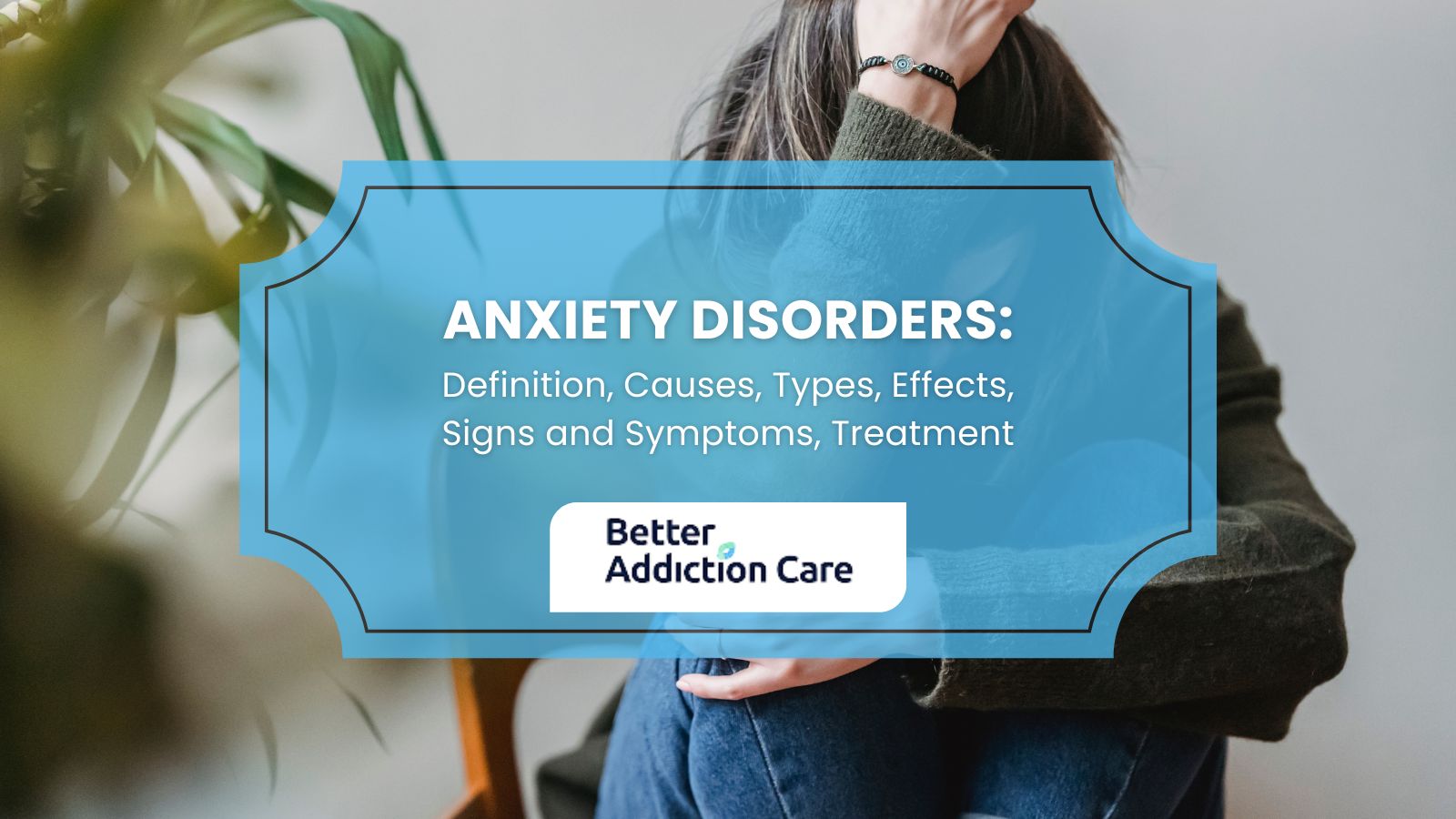
Anxiety disorders are mental health conditions marked by persistent fear, worry, or nervousness that interferes with daily life. Unlike occasional anxiety, these disorders involve intense symptoms that disrupt thinking, emotions, and behavior, making it difficult to function socially and professionally. An estimated 19.1% of U.S. adults experienced any anxiety disorder in the past year, with higher rates among females (23.4%) compared to males (14.3% according to the National Institute of Mental Health (NIMH), "Any Anxiety Disorder" in 2023.
The causes of anxiety disorders include genetics, trauma, ongoing stress, and chemical imbalances in the brain. Family history of mental illness, unresolved emotional trauma, chronic health problems, or high-pressure environments increase the risk of developing an anxiety disorder.
Types of anxiety disorders include Generalized Anxiety Disorder (GAD), Panic Disorder, Social Anxiety Disorder, and specific phobias. Other forms include Agoraphobia and Separation Anxiety Disorder. Each type involves unique triggers and symptoms but stems from the same root problem: overwhelming fear.
Anxiety disorders affect the body and mind. Emotionally, they lead to irritability, indecisiveness, and disconnection. Physically, they cause sleep disturbances, muscle tension, headaches, and fatigue. Without treatment, symptoms intensify and disrupt relationships, health, and daily performance.
Signs and symptoms include restlessness, constant worry, muscle tension, rapid heartbeat, sweating, and nausea. These symptoms arise in response to stress or appear suddenly, interfering with personal, social, and work life.
Treatment includes Cognitive Behavioral Therapy (CBT), medication, and lifestyle changes. Therapy rewires thought patterns, medications stabilize brain chemistry, and self-care strategies, such as regular exercise, sleep, and mindfulness, support long-term recovery. With the right treatment, lasting relief is possible.
What is Anxiety Disorder?
Anxiety disorders are mental health conditions defined by persistent, excessive worry or fear that is difficult to control and disrupts daily functioning. It is the most common type of mental disorder, affecting how a person feels, thinks, and behaves in response to perceived threats or stressors.
There are several forms of anxiety disorders. Generalized Anxiety Disorder (GAD) involves ongoing, excessive worry about a variety of topics. Panic Disorder is marked by sudden episodes of intense fear. Obsessive-Compulsive Disorder (OCD) causes unwanted, recurring thoughts and repetitive behaviors. Post-Traumatic Stress Disorder (PTSD) develops after experiencing or witnessing traumatic events. The most common anxiety disorder is Specific phobia. Specific phobias affect 19.3 million adults or 9.1% of the U.S. population,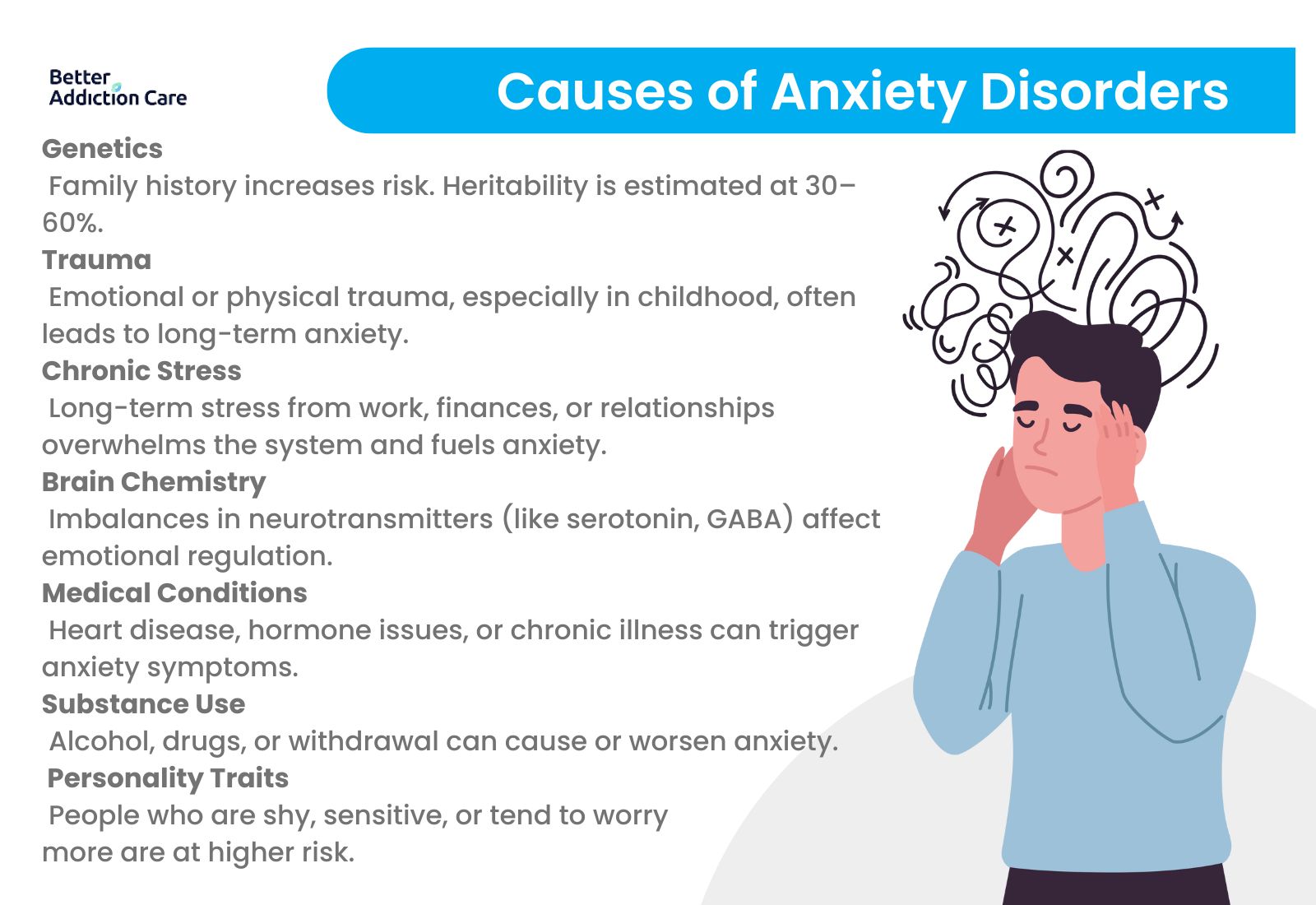 according to the NIMH in a study titled “Specific Phobias”. Phobias involve intense fears of specific objects or situations, such as flying, heights, or social interactions.
according to the NIMH in a study titled “Specific Phobias”. Phobias involve intense fears of specific objects or situations, such as flying, heights, or social interactions.
What are the Causes of Anxiety Disorders?
The causes of anxiety disorder include a combination of genetic, environmental, psychological, and biological factors. Anxiety does not develop from a single source but emerges from a complex interaction of personal experiences and internal vulnerabilities.
Common causes of anxiety disorder include:
-
Genetics: A family history of anxiety or related conditions increases the likelihood of developing the disorder. Twin studies indicate anxiety disorders have a heritability of 30–60%, while genome-wide analyses estimate common genetic variants account for 26–31% of the heritability for lifetime anxiety disorders according to “A major role for common genetic variation in anxiety disorders” by Molecular Psychiatry.
-
Trauma: Experiencing physical, emotional, or psychological trauma, especially in childhood, leads to long-term anxiety. 36.3% of PTSD cases involve comorbid social phobia, while 17.9% involve comorbid agoraphobia/panic disorders according to Qassem T. et. al. 2021 “Psychiatric Co-Morbidities in Post-Traumatic Stress Disorder: Detailed Findings from the Adult Psychiatric Morbidity Survey in the English Population,” published by Psychiatric Quarterly.
-
Chronic stress: Ongoing pressure from work, relationships, or financial issues strains the body and mind, leading to anxiety.
-
Brain chemistry: Imbalances in neurotransmitters disrupt emotional regulation and heighten sensitivity to stress.
-
Medical conditions: Heart problems, hormonal imbalances, or chronic illnesses trigger or mimic anxiety symptoms.
-
Substance use: Alcohol, drugs, or withdrawal from certain medications induces or exacerbates anxiety. Among individuals with anxiety disorders, 33% to 45% have a co-occurring substance use disorder (SUD) within the same 12-month period. This rate is significantly higher than in the general population according to Psychiatric Times, "Anxiety Disorders With Comorbid Substance Abuse" in 2011.
-
Personality traits: People who are more sensitive, shy, or prone to negative thinking are more vulnerable to anxiety disorders.
What are the Types of Anxiety Disorders?
The types of anxiety disorders include several distinct conditions, each with its own characteristics, triggers, and symptoms, but all involving intense and persistent fear or worry. While they share overlapping features, the nature of the anxiety and how it affects daily life varies depending on the disorder.

The different types of anxiety disorders are detailed below:
Generalized Anxiety Disorder (GAD)
GAD involves chronic and exaggerated worry about everyday issues such as work, health, or social situations. This worry is difficult to control and usually lasts for six months or more, leading to restlessness, fatigue, and trouble concentrating. An estimated 3.1% of U.S. adults (approximately 6.8 million people) experience GAD in a given year, with women twice as likely to be affected as men according to Anxiety & Depression Association of America (ADAA), "Facts & Statistics" in 2022.
Panic Disorder
Panic disorder is defined by sudden and repeated episodes of intense fear known as panic attacks. These attacks produce physical symptoms like chest pain, heart palpitations, dizziness, or shortness of breath and occur without warning. Approximately 4.7% of U.S. adults will experience panic disorder at some point in their lives according to “Panic Disorder” published by the National Institute of Mental Health (NIMH).
Social Anxiety Disorder
Social anxiety disorder causes overwhelming fear in social or performance situations. Individuals may worry about being judged, embarrassed, or rejected, which results in avoidance of public settings or severe distress during interactions. An estimated 12.1% of U.S. adults will experience SAD at some point in their lives according to the National Institute of Mental Health in “Social Anxiety Disorder”.
Specific Phobias
Specific phobias are intense fears of particular objects or situations, such as heights, flying, or animals. The fear goes beyond what is appropriate and leads to avoidance behavior that disrupts normal functioning. Approximately 12.5% of U.S. adults experience specific phobia at some point in their lives, with higher rates among women (12.2% past-year prevalence) compared to men (5.8%) according to National Institute of Mental Health (NIMH), "Specific Phobia".
Obsessive-Compulsive Disorder (OCD)
OCD is marked by recurring, unwanted thoughts (obsessions) and repetitive behaviors (compulsions) performed to reduce anxiety. Common examples include excessive cleaning, checking, or counting rituals. According to the National Institute of Mental Health (NIMH) in a study titled "Obsessive-Compulsive Disorder (OCD)" the U.S. prevalence rates of OCD, including past-year (1.2%) and lifetime (2.3%) diagnoses, gender disparities, and severity levels.
What are the Effects of Anxiety Disorders?
The effects of anxiety disorders include disruptions in emotional, physical, and cognitive functioning. These disorders interfere with daily responsibilities, relationships, and overall quality of life. When left untreated, anxiety disorders lead to persistent stress responses that affect the brain and body, contributing to a range of long-term complications. These effects are not just internal, they are visible in behavior, work performance, and social interaction.
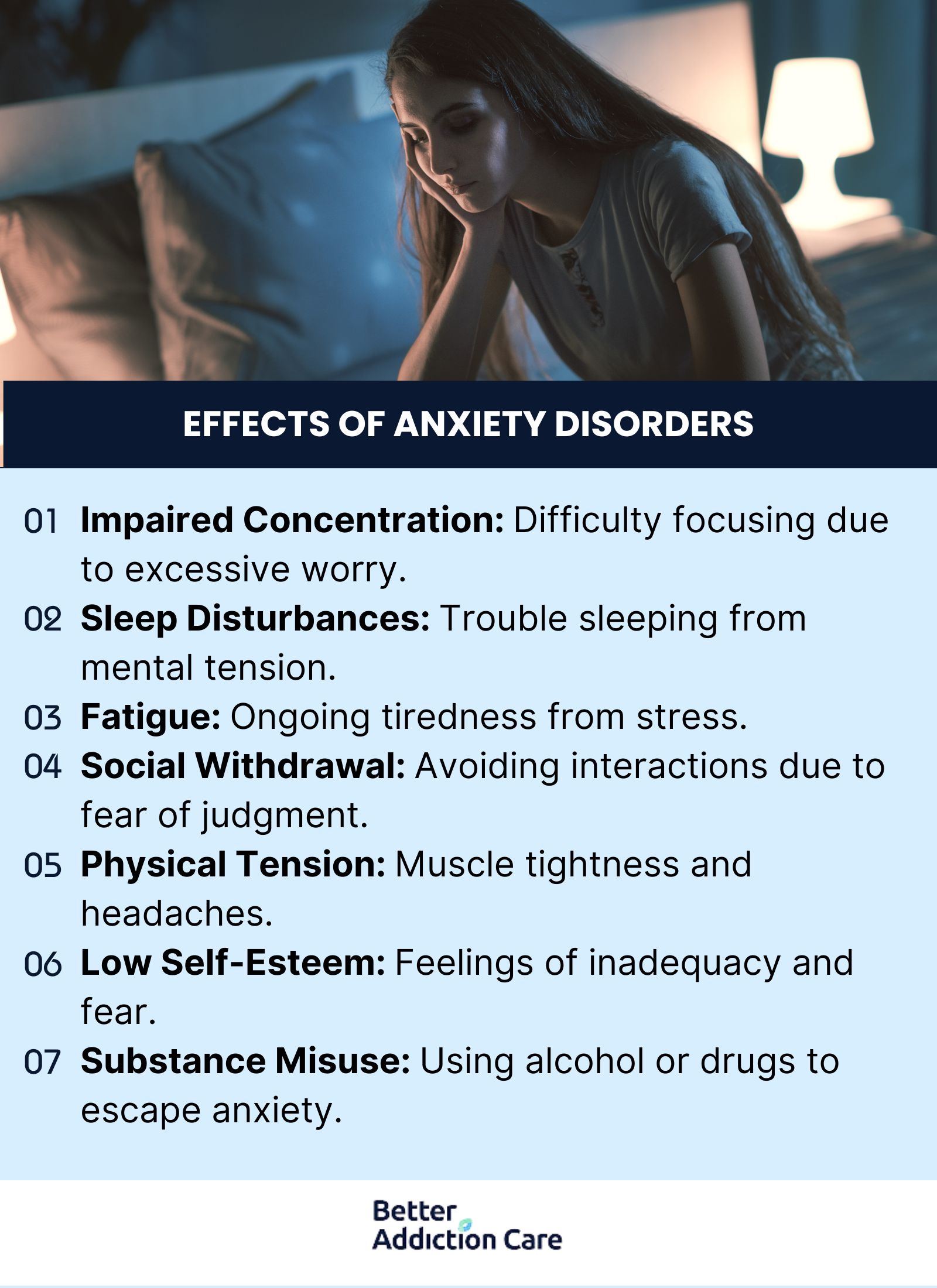
The most common effects of anxiety disorders include:
-
Impaired Concentration: Difficulty focusing or staying attentive due to excessive worry or racing thoughts.
-
Sleep Disturbances: Trouble falling asleep, staying asleep, or experiencing restful sleep because of ongoing mental tension.
-
Fatigue: Persistent tiredness caused by the mental strain of worry and lack of restorative rest.
-
Social Withdrawal: Avoidance of social events or interactions due to fear of judgment or embarrassment.
-
Physical Tension: Chronic muscle tightness, headaches, or body aches resulting from sustained stress responses.
-
Low Self-Esteem: Feelings of inadequacy, failure, or shame rooted in ongoing self-doubt and fear.
-
Substance Misuse: Use of alcohol or drugs as a way to numb or escape overwhelming anxiety symptoms.
What are the Signs and Symptoms of Anxiety Disorder?
The most common signs and symptoms of anxiety disorder are persistent fear, restlessness, physical tension, and irrational worry. People with anxiety disorder feel constantly on edge, experience difficulty focusing, and react intensely to stress. The condition affects the body, mind, and behavior, often resulting in panic attacks and avoidance of anxiety-triggering situations.
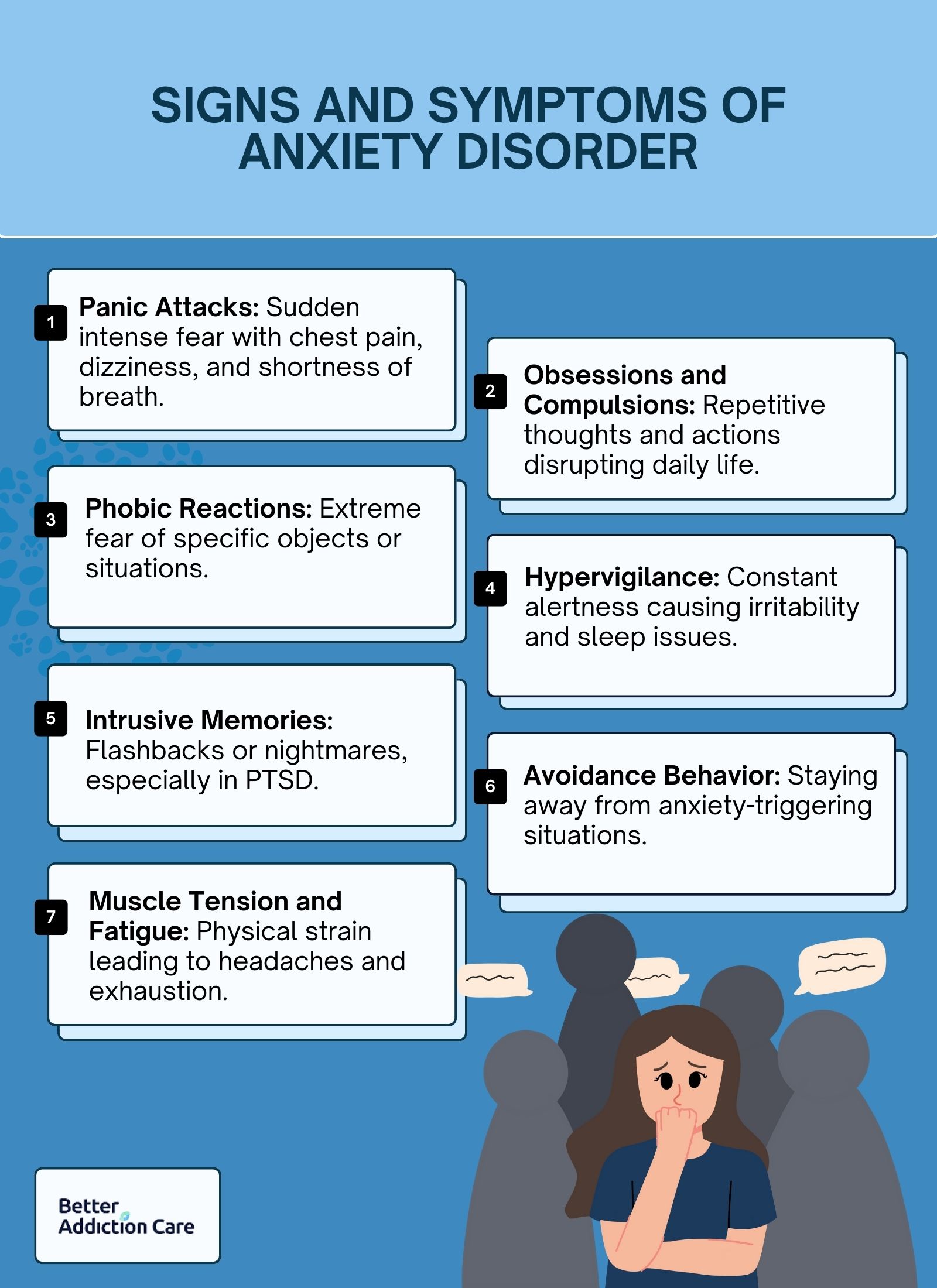
The most severe symptoms of anxiety disorder are given below:
-
Panic attacks: Sudden episodes of intense fear that trigger physical symptoms like chest pain, dizziness, and shortness of breath.
-
Obsessions and compulsions: Repetitive thoughts and behaviors that interfere with daily life, often seen in obsessive-compulsive disorder.
-
Phobic reactions: Extreme fear responses to specific objects or situations, such as heights, flying, or social settings.
-
Hypervigilance: A constant state of alertness that causes irritability, sleep problems, and difficulty relaxing.
-
Intrusive memories: Unwanted flashbacks or nightmares, especially in people with post-traumatic stress disorder.
-
Avoidance behavior: Deliberately staying away from places, people, or situations that trigger anxiety.
-
Muscle tension and fatigue: Ongoing physical strain in the body, leading to headaches, exhaustion, and general discomfort.
What are the Symptoms of Anxiety Disorder in Females?
The symptoms of anxiety disorder in females typically present through a combination of emotional and physical symptoms. Women may experience persistent worry, irritability, and difficulty concentrating. Physical signs such as muscle tension, fatigue, and disrupted sleep patterns are common. Hormonal fluctuations, such as those occurring during menstruation, pregnancy, or menopause, may heighten symptoms. Females might also internalize their anxiety, making it less visible to others but deeply disruptive to their well-being and daily routine. 23.4% of U.S. adult women experience any anxiety disorder annually, compared to 14.3% of men. This represents a 1.6:1 female-to-male ratio in anxiety diagnoses according to the National Institute of Mental Health (NIMH), "Any Anxiety Disorder" in 2023.
What are the Symptoms of Anxiety Disorder in Children?
The symptoms of anxiety disorder in children are expressed through behaviors that reflect fear, avoidance, or distress. They may become excessively clingy, especially with parents or caregivers, or refuse to go to school. Emotional outbursts, frequent stomachaches, headaches, or difficulty sleeping are also typical signs. Children with anxiety might struggle to articulate their feelings, instead showing signs through restlessness, irritability, or withdrawal from activities they once enjoyed. Left unaddressed, these symptoms can impact learning, social development, and overall confidence.
What are the Symptoms of Anxiety Disorder in Dogs?
The symptoms of anxiety in dogs include changes in behavior and physical symptoms. Common signs include excessive barking, pacing, trembling, and destructive behavior like chewing or digging. Some dogs develop separation anxiety and display panic when left alone, while others become unusually aggressive or withdrawn. They also lose their appetite, drool excessively, or have accidents indoors. These symptoms reflect a state of persistent unease and fear, often triggered by environmental changes, trauma, or lack of proper socialization. Approximately 72.5% of dogs exhibit anxiety-like behaviors, with noise sensitivity (32%) and general fearfulness (29%) being the most common traits. Fear of strangers and separation-related anxiety have surged post-pandemic, with separation anxiety increasing by over 700% in dogs between 2020 and 2022 according to Cohut, M. et. al. 2020 in Medical News Today.
What are the Treatments of Anxiety Disorder?
The treatments of anxiety disorder include self-care strategies, counseling, therapy, and medications. A combination of these approaches helps reduce symptoms, improve emotional stability, and restore daily functioning. The choice of treatment depends on the severity of the disorder, individual needs, and coexisting health conditions.
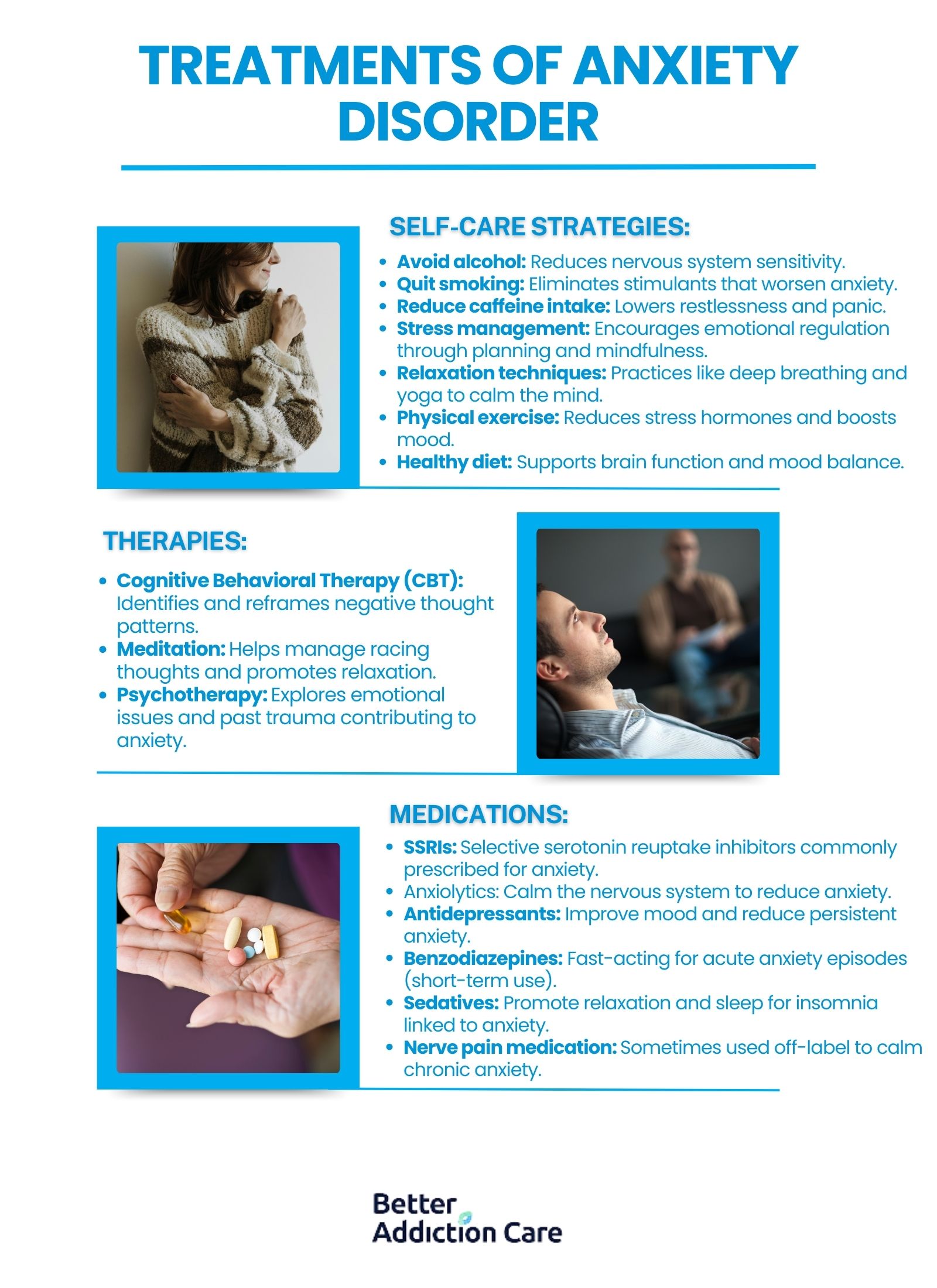
Self Care
Self-care plays a critical role in managing anxiety disorder by promoting healthier routines and reducing exposure to triggers. These lifestyle changes help regulate the nervous system and support emotional well-being. A 2023 study of 245 patients with anxiety disorders found that higher self-management scores were negatively correlated with anxiety severity (r = –0.470, p <0.001) and positively correlated with quality of life (r = 0.695, p <0.001). Self-management mediated 38% of the total effect of anxiety on quality of life, indicating its significant role in symptom reduction according to PMC, "Relationship between self-management of patients with anxiety disorders and anxiety and quality of life" in 2023.
Self-care strategies are given below:
-
Avoid alcohol: Reduces nervous system sensitivity and prevents mood fluctuations.
-
Quit smoking: Eliminates stimulants that increase anxiety symptoms.
-
Reduce caffeine intake: Helps lower restlessness, jitteriness, and panic symptoms.
-
Implement stress management: Encourages better emotional regulation through planning and mindfulness.
-
Practice relaxation techniques: Techniques like deep breathing and yoga help calm the mind.
-
Engage in physical exercise: Regular activity reduces stress hormones and boosts mood.
-
Maintain a healthy diet: Nutrient-rich foods support brain function and mood balance.
Therapies
Therapy is a key component in treating anxiety disorder by targeting negative thinking patterns, improving coping skills, and fostering emotional resilience. Cognitive Behavioral Therapy (CBT) shows an average 49.5% response rate at post-treatment and 53.6% at follow-up across anxiety disorders, though remission rates vary by diagnostic criteria (e.g., 51% remission when defined as loss of diagnosis vs. 42.5% when using clinical cutoffs) according to “Response rates for CBT for anxiety disorders: Need for standardized criteria”according to the Clinical Psychology Review.
The therapies used in anxiety are included below:
-
Cognitive behavioral therapy: Focuses on identifying and reframing negative thought patterns that fuel anxiety.
-
Meditation: Enhances awareness and relaxation, helping manage racing thoughts.
-
Psychotherapy: Provides a space to explore emotional issues and past trauma contributing to anxiety.
Medications
Medication is prescribed when symptoms are severe or do not respond to therapy alone. Medication-Assisted Therapy helps balance brain chemicals and relieve symptoms. Antidepressants, such as SSRIs and SNRIs, demonstrate a 41% higher treatment response rate compared to placebo in individuals with generalized anxiety disorder (GAD), measured as a reduction of at least 50% on the Hamilton Anxiety Rating Scale. The number needed to treat (NNT) for an additional beneficial outcome is 7 according to PubMed, "Antidepressants versus placebo for generalised anxiety disorder" in 2025.
The medications used for anxiety disorders include:
-
SSRIs: Selective serotonin reuptake inhibitors are the most commonly prescribed antidepressants for anxiety.
-
Anxiolytic: Medications that reduce anxiety by calming the nervous system.
-
Antidepressant: Help improve mood and reduce persistent anxiety symptoms.
-
Benzodiazepines: Fast-acting sedatives used short-term to control acute anxiety episodes.
-
Sedative: Used to promote relaxation and sleep for individuals experiencing insomnia linked to anxiety.
-
Nerve pain medication: Sometimes used off-label to calm nerve overactivity related to chronic anxiety.
Is Anxiety Disorder Treatment Covered By Insurance?
Yes, anxiety disorder treatment is typically covered by insurance. Most health insurance plans, whether private, employer-sponsored, or government-funded, include mental health benefits that cover the diagnosis and treatment of anxiety disorders. This coverage often includes therapy (such as cognitive behavioral therapy), psychiatric evaluations, and medication. However, the extent of coverage, co-pays, deductibles, and network restrictions vary by plan. To understand exactly what is covered, it’s best to contact your insurance provider or ask a treatment center to verify your benefits on your behalf.
How Common Are Anxiety Disorders?
Anxiety disorders are very common and among the most common mental health conditions in the United States. Approximately 19.1% of adults experience an anxiety disorder each year, with women affected more frequently than men (23.4% vs. 14.3%). Each year, over 48 million American adults are impacted by some form of anxiety disorder, according to national health statistics according to the National Institute of Mental Health.
Can Anxiety Disorder Cause Depression?
Yes, anxiety disorder can lead to depression. Chronic anxiety places immense stress on the brain and body, which over time may trigger feelings of hopelessness, low self-worth, and emotional exhaustion, hallmarks of clinical depression. The constant state of fear or worry can interfere with relationships, work, and daily activities, eventually deepening into a depressive episode. Depression and anxiety disorders frequently overlap, with 45–67% of individuals diagnosed with a depressive disorder also meeting criteria for at least one anxiety disorder, and 30–63% of those with an anxiety disorder experiencing concurrent depression according to Kircanski, K. et. al. 2016 in “Investigating the nature of co-occurring depression and anxiety: Comparing diagnostic and dimensional research approaches”.
How Do Neurotransmitters Affect Anxiety?
Neurotransmitters affect anxiety in the regulation of mood and stress responses, directly influencing anxiety levels. Chemical messengers such as serotonin, dopamine, gamma-aminobutyric acid (GABA), and norepinephrine help transmit signals in the brain that control feelings of calm or alertness. Imbalances in these neurotransmitters, especially low levels of serotonin and GABA or elevated norepinephrine, are linked to increased anxiety. Treatment approaches like medication or cognitive behavioral therapy aim to restore this chemical balance to reduce symptoms.
How Does Alcohol Addiction Affect Anxiety Disorders?
Alcohol addiction affects anxiety disorders by intensifying symptoms and interfering with effective treatment. Although alcohol initially seems to provide relief from anxiety, it disrupts brain chemistry, increasing feelings of panic, irritability, and emotional instability over time. This creates a harmful cycle, where anxiety leads to drinking, and drinking deepens anxiety, making both conditions harder to manage. Long-term alcohol addiction also reduces the effectiveness of medications prescribed for anxiety and complicates therapy outcomes. For individuals with co-occurring anxiety and alcohol use disorders, integrated treatment is essential for lasting recovery.
Can You Get Rid of Anxiety Disorder?
Yes, you can get rid of anxiety disorder and many people achieve full recovery with appropriate medical care. While it might not permanently disappear for everyone, consistent treatment, such as therapy, medication, and lifestyle changes, leading to significant improvement or complete remission of symptoms. Early diagnosis and a personalized treatment plan are necessary for long-term relief and improved quality of life.
Who Are the Specialists of Anxiety Disorder?
Specialists who treat anxiety disorders include clinical psychologists, psychiatrists, and primary care providers.
The specialists are detailed below:
- Clinical psychologists use therapy, especially cognitive behavioral therapy, to help patients understand and manage anxiety triggers.
- Psychiatrists diagnose anxiety disorders and prescribe medications that balance brain chemistry and reduce symptoms.
- Primary care providers (PCPs) can perform initial assessments, rule out underlying medical issues, and refer patients to mental health professionals for specialized care.
Related Articles
Treatment Centers in New Jersey






